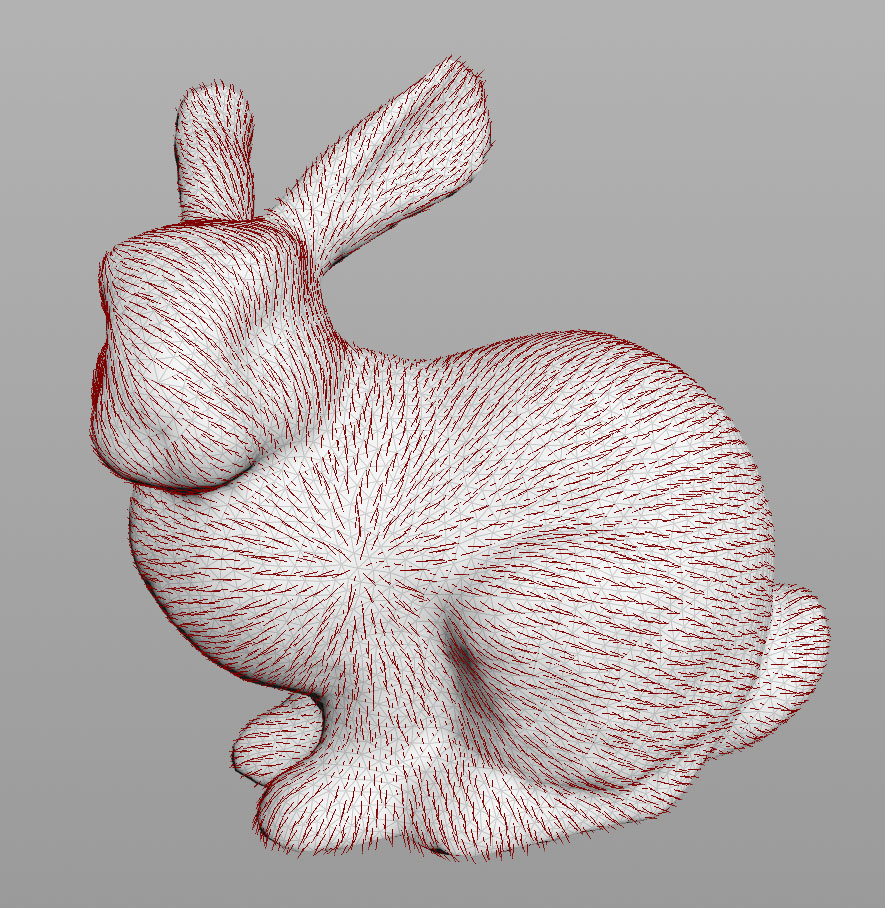Measuring geodesic distances and the computation of paths on a mesh is widely used in computational geometry for many different applications ranging from mesh parameterization and remeshing to skinning and mesh deformation. After a longer conversation and chat about this topic, and since i thought it could be useful at some point I finally got my feet wet on different algorithms to compute such geodesics in Houdini.
The first and obvious choice was to compute the shortest path between the source point and all the other points on the geometry. This was easy and fast to do but unfortunately it doesn’t compute geodesics. Since the underlying algorithm of the ShortestPathSop (Dijkstra) relies on the edges of the mesh, it computes just a rough approximation of the real distances. Of course, the inaccuracy could be minimized by iteratively smoothing the paths but still, the result will be far from being optimal and the method slow as well.
To circumvent this problem, I tried another method. Instead of measuring the length of the shortest paths directly it relied on the fact that a real geodesic path unfolds into a straight line. So, what I basically did was:
- Compute the shortest path between point A and point B
- Unfold the path onto a plane
- Measure the Euclidian distance between point A and point B on the unfolded path.
This method worked quite nicely but it has one big drawback – it doesn’t work on meshes with holes. As soon as the line drawn between the start- and endpoint of the unfolded path crosses a hole, the result is no longer the true geodesic distance.
The third algorithm I´ve used was the well known Fast Marching Front Propagation Method. You start at the single source point and compute the distance to the 1-ring neighbouring points around it. By doing this iteratively and summing up the distances you´ll finally get the geodesic distance to all points in the mesh. This works because it is easy to calculate the distance to the third point of a triangle as soon as the other two distances are known.
For the first quick implementation i used python but it was way to slow to be usable. After replacing the slow list lookups in the code i got a 3 times speedup but it was still to slow which was the reason for porting the algorithm to the HDK. After that, it worked quite fast (around 270 times faster) but the general problem with this algorithm is, that it doesn´t work with obtuse triangles. In other words, it needs to work on a fairly clean and regular triangulated mesh. If this is not the case, you´ll end up with errors in the distance calculation which leads to larger errors and so forth. To prevent this from happening I had to insert conditional statements for obtuse triangles as well for all other special cases and hence the code got much longer and somewhat cluttered. Usually, when fast marching front propagation is used on 2D and 3D grids, this is not a problem but for arbitrarily triangulated meshes it is.
Finally I decided to implement the great paper: “Geodesics in Heat” by Keenan Crane. The method described in the paper works basically as follows:
- Integrate the heat flow for a source point across the mesh
- Compute the normalized gradient for the heat
- Solve the Poisson equation to get the actual distance
One of the great advantages of the heat method is its brilliant simplicity. Basically it relies only on solving a sparse linear system what could be done quite efficiently by various linear algebra libraries (I’ve used Eigen for this). This makes it possible to compute the geodesic distances from more than one point in pretty much the same computation time, quite contrary to the marching method for example.
For some related reading:
K. Crane, C. Weischedel, M. Wardetzky: The Heat Method for Distance Computation
M. Novotni, R. Klein: Computing Geodesic Distances on Triangular Meshes
V. Surazhsky, T. Surazhsky, D. Kirsanov, S. J. Gortler, H. Hoppe: Fast Exact and Approximate Geodesics on Meshes
D. Bommes, L. Kobbelt: Accurate Computation of Geodesic Distance Fields for Polygonal Curves on Triangle Meshes














This blog is excellent, very inspiring! Thank you for publishing on it!
Is the code or hip files available somewhere for download (github perhaps)? It’d be great to learn from how you’ve implemented these papers in Houdini.
LikeLike
i didn’t upload the code to github but the very first prototype of the marching front algorithm is posted on odforce. same goes for the method using the unfolded shortest paths.
http://forums.odforce.net/topic/26997-distance-on-mesh/#comment-155547
http://forums.odforce.net/topic/21387-is-there-a-way-to-use-point-clouds-while-respecting-surface-connectivi/?do=findComment&comment=127918
the implementation of “geodesics in heat” is part of a larger proprietary toolset and unfortunately i can’t share it. but if you are doing your own implementation i’m willing to help as much as i can. just let me know …
LikeLike
No problem, I understand. Thanks for those links
LikeLike
Hey,
Great work. Minor question –
Which plane did unfold your shortest path on? How did you define this plane?
Regards,
Shubhendu
LikeLike
Hi,
Really nice article! I am curious how do you extract the contour lines, i.e. distance isolines? is it some sort of a traverse from edge to edge using linear interpolation of the distance values in vertices or something more complicated?
btw: the last article you’ve mentioned (Bommes, Kobbelt) describes the mesh subdivision algorithm to get accurate isolines.
LikeLike